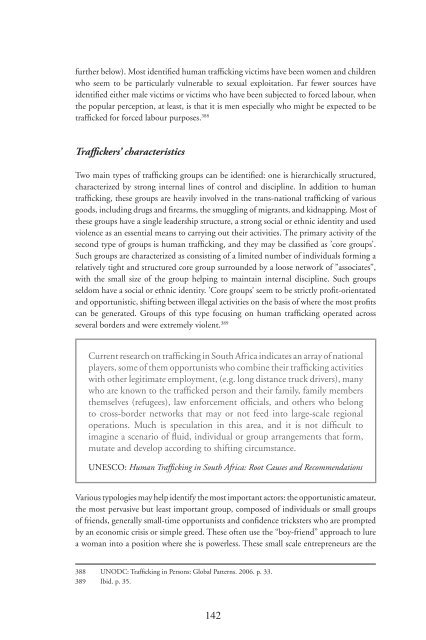Trafficking in human beings: human rights and ... - unesdoc - Unesco
Trafficking in human beings: human rights and ... - unesdoc - Unesco
Trafficking in human beings: human rights and ... - unesdoc - Unesco
Create successful ePaper yourself
Turn your PDF publications into a flip-book with our unique Google optimized e-Paper software.
further below). Most identifi ed <strong>human</strong> traffi ck<strong>in</strong>g victims have been women <strong>and</strong> children<br />
who seem to be particularly vulnerable to sexual exploitation. Far fewer sources have<br />
identifi ed either male victims or victims who have been subjected to forced labour, when<br />
the popular perception, at least, is that it is men especially who might be expected to be<br />
traffi cked for forced labour purposes. 388<br />
Traffi ckers’ characteristics<br />
Two ma<strong>in</strong> types of traffi ck<strong>in</strong>g groups can be identifi ed: one is hierarchically structured,<br />
characterized by strong <strong>in</strong>ternal l<strong>in</strong>es of control <strong>and</strong> discipl<strong>in</strong>e. In addition to <strong>human</strong><br />
traffi ck<strong>in</strong>g, these groups are heavily <strong>in</strong>volved <strong>in</strong> the trans-national traffi ck<strong>in</strong>g of various<br />
goods, <strong>in</strong>clud<strong>in</strong>g drugs <strong>and</strong> fi rearms, the smuggl<strong>in</strong>g of migrants, <strong>and</strong> kidnapp<strong>in</strong>g. Most of<br />
these groups have a s<strong>in</strong>gle leadership structure, a strong social or ethnic identity <strong>and</strong> used<br />
violence as an essential means to carry<strong>in</strong>g out their activities. The primary activity of the<br />
second type of groups is <strong>human</strong> traffi ck<strong>in</strong>g, <strong>and</strong> they may be classifi ed as ’core groups’.<br />
Such groups are characterized as consist<strong>in</strong>g of a limited number of <strong>in</strong>dividuals form<strong>in</strong>g a<br />
relatively tight <strong>and</strong> structured core group surrounded by a loose network of ”associates”,<br />
with the small size of the group help<strong>in</strong>g to ma<strong>in</strong>ta<strong>in</strong> <strong>in</strong>ternal discipl<strong>in</strong>e. Such groups<br />
seldom have a social or ethnic identity. ’Core groups’ seem to be strictly profi t-orientated<br />
<strong>and</strong> opportunistic, shift<strong>in</strong>g between illegal activities on the basis of where the most profi ts<br />
can be generated. Groups of this type focus<strong>in</strong>g on <strong>human</strong> traffi ck<strong>in</strong>g operated across<br />
several borders <strong>and</strong> were extremely violent. 389<br />
Current research on traffi ck<strong>in</strong>g <strong>in</strong> South Africa <strong>in</strong>dicates an array of national<br />
players, some of them opportunists who comb<strong>in</strong>e their traffi ck<strong>in</strong>g activities<br />
with other legitimate employment, (e.g. long distance truck drivers), many<br />
who are known to the traffi cked person <strong>and</strong> their family, family members<br />
themselves (refugees), law enforcement offi cials, <strong>and</strong> others who belong<br />
to cross-border networks that may or not feed <strong>in</strong>to large-scale regional<br />
operations. Much is speculation <strong>in</strong> this area, <strong>and</strong> it is not diffi cult to<br />
imag<strong>in</strong>e a scenario of fl uid, <strong>in</strong>dividual or group arrangements that form,<br />
mutate <strong>and</strong> develop accord<strong>in</strong>g to shift<strong>in</strong>g circumstance.<br />
UNESCO: Human Traffi ck<strong>in</strong>g <strong>in</strong> South Africa: Root Causes <strong>and</strong> Recommendations<br />
Various typologies may help identify the most important actors: the opportunistic amateur,<br />
the most pervasive but least important group, composed of <strong>in</strong>dividuals or small groups<br />
of friends, generally small-time opportunists <strong>and</strong> confi dence tricksters who are prompted<br />
by an economic crisis or simple greed. These often use the “boy-friend” approach to lure<br />
a woman <strong>in</strong>to a position where she is powerless. These small scale entrepreneurs are the<br />
388 UNODC: Traffi ck<strong>in</strong>g <strong>in</strong> Persons: Global Patterns. 2006. p. 33.<br />
389 Ibid. p. 35.<br />
142

















